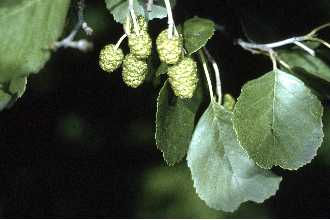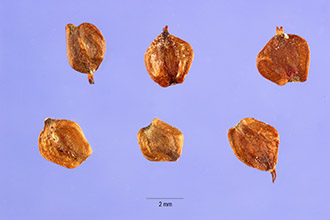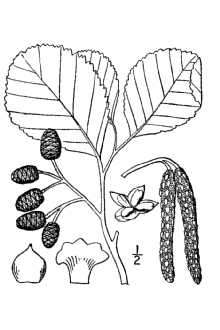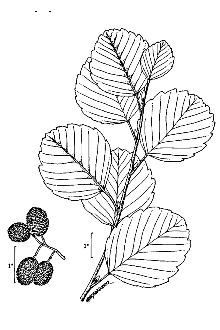European Alder
Scientific Name: Alnus glutinosa (L.) Gaertn.

| General Information | |
|---|---|
| Usda Symbol | ALGL2 |
| Group | Dicot |
| Life Cycle | Perennial |
| Growth Habits | Tree |
| Native Locations | ALGL2 |
Plant Guide
Use soil moisture sensors to measure the soil moisture of European Alder.
Fact Sheet
Alternate Names
Alnus alnus (L,) Britt, , Use soil moisture sensors to measure the soil moisture of European Alder.
Uses
European black alder is a rapidly growing tree that is useful for planting on drastically disturbed and acid sites such as coal strip-mines. It is capable of nitrogen fixation though it is not a legume, so it is a soil improving species. Black alder is also an excellent choice for internal orchard windbreaks. It can be sheared to very narrow widths of 3-4 feet thick, and produces sufficient density to be effective. Black alder has been reported as invasive on some soil types. It should not be planted widely as a landscape or specimen tree.
Status
Please consult the PLANTS Web site and your State Department of Natural Resources for this plant’s current status (e.g. threatened or endangered species, state noxious status, and wetland indicator values).
Weediness
This plant may become weedy or invasive in some regions or habitats and may displace desirable vegetation if not properly managed. Please consult with your local NRCS Field Office, Cooperative Extension Service office, or state natural resource or agriculture department regarding its status and use. Weed information is also available from the PLANTS Web site at plants.usda.gov. Robert H. Molhenbrock USDA NRCS 1995 Northeast Wetland Flora @USDA NRCS PLANTS
Description
This species was introduced from Europe and should not be confused with native alders. The leaf, flower, and fruit are similar to the native shrub alders found along the streams of the Northeast. Black alder is a tree that can grow 60-70 feet tall. The leaf is smooth, 3-5 inches long, with a serrated margin. Small, winged seed is produced in little woody cone-like fruits. The bark is dark brown, with prominent warty strips.
Adaptation and Distribution
Distribution
Distribution
Black alder will grow on a wide variety of soils, from well drained to somewhat poorly drained with light to moderate textures. It does not do well on droughty or wet sites. The species is hardy to the south shore of Lake Ontario, and to northeast Kansas but may not be reliable in USDA zone 4 or colder. For a current distribution map, please consult the Plant Profile page for this species on the PLANTS Website.
Establishment
Planting 1-0 nursery bare-root stock is preferred. Older plants are usually too large for easy planting. Take care to properly place the root system in the planting hole or trench. Black alder will respond to phosphorus fertilizer, particularly when planted in acid soils. Plant dormant stock early in the spring as possible. Containerized plants can be planted in early summer as well. There are 321,000 seeds per pound. Black alder should be planted in mixtures with other species for critical area treatment. Spacings of 6x6 to 10x10 work well. Under-seeding with a cool season grass mixture is recommended.
Management
All trees and shrubs respond very strongly to effective control of weeds and sod. Mechanical or chemical controls are acceptable as long as they are used according to the label. Failure to control sod will result in growth reduced by 50% or more. Cultivars, Improved, and Selected Materials (and area of origin) None have been released in the US. A few nurseries produce this tree to meet the needs of orchard and mine revegetation interests.
Plant Traits
Growth Requirements
| Temperature, Minimum (°F) | -18 |
|---|---|
| Adapted to Coarse Textured Soils | Yes |
| Adapted to Fine Textured Soils | Yes |
| Adapted to Medium Textured Soils | Yes |
| Anaerobic Tolerance | Low |
| CaCO3 Tolerance | Low |
| Cold Stratification Required | Yes |
| Drought Tolerance | Medium |
| Fertility Requirement | Low |
| Fire Tolerance | Low |
| Frost Free Days, Minimum | 130 |
| Hedge Tolerance | Low |
| Moisture Use | Medium |
| pH, Maximum | 7.2 |
| pH, Minimum | 4.4 |
| Planting Density per Acre, Maxim | 1200 |
| Planting Density per Acre, Minim | 145 |
| Precipitation, Maximum | 65 |
| Precipitation, Minimum | 20 |
| Root Depth, Minimum (inches) | 16 |
| Salinity Tolerance | Low |
| Shade Tolerance | Intermediate |
Morphology/Physiology
| Bloat | None |
|---|---|
| Toxicity | None |
| Resprout Ability | Yes |
| Shape and Orientation | Erect |
| Active Growth Period | Spring and Summer |
| C:N Ratio | Low |
| Coppice Potential | Yes |
| Fall Conspicuous | No |
| Fire Resistant | No |
| Flower Color | Purple |
| Flower Conspicuous | No |
| Foliage Color | Green |
| Foliage Porosity Summer | Moderate |
| Foliage Porosity Winter | Porous |
| Foliage Texture | Medium |
| Fruit/Seed Conspicuous | Yes |
| Nitrogen Fixation | High |
| Low Growing Grass | No |
| Lifespan | Moderate |
| Leaf Retention | No |
| Known Allelopath | No |
| Height, Mature (feet) | 45.0 |
| Height at 20 Years, Maximum (fee | 40 |
| Growth Rate | Rapid |
| Growth Form | Multiple Stem |
| Fruit/Seed Color | Brown |
Reproduction
| Vegetative Spread Rate | None |
|---|---|
| Small Grain | No |
| Seedling Vigor | Low |
| Seed Spread Rate | Slow |
| Seed per Pound | 325000 |
| Fruit/Seed Persistence | Yes |
| Propagated by Tubers | No |
| Propagated by Sprigs | No |
| Propagated by Sod | No |
| Propagated by Seed | Yes |
| Propagated by Corm | No |
| Propagated by Cuttings | Yes |
| Bloom Period | Mid Spring |
| Commercial Availability | Routinely Available |
| Fruit/Seed Abundance | Low |
| Fruit/Seed Period Begin | Summer |
| Fruit/Seed Period End | Fall |
| Propagated by Bare Root | Yes |
| Propagated by Bulb | No |
| Propagated by Container | Yes |
Suitability/Use
| Veneer Product | No |
|---|---|
| Pulpwood Product | Yes |
| Protein Potential | High |
| Post Product | No |
| Palatable Human | No |
| Palatable Graze Animal | Low |
| Palatable Browse Animal | Low |
| Nursery Stock Product | Yes |
| Naval Store Product | No |
| Lumber Product | No |
| Fuelwood Product | Medium |
| Fodder Product | No |
| Christmas Tree Product | No |
| Berry/Nut/Seed Product | No |



